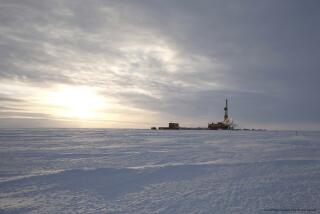Midnight sun shines on hot market
- Share via
When Santa Claus House in North Pole, Alaska, needed an addition built, the call went to Liberty Homes, a local builder and residential real estate brokerage owned by Realtor Debra Rosson and her home-builder husband, Bud.
“He builds homes and I sell them,” said Rosson from her home office about a mile from Santa’s red-and-white striped home, which is actually a gift shop and tourist attraction.
Rosson, who has been selling real estate for 26 years, is a North Dakota native who moved to North Pole 45 years ago to be close to her grandmother, a schoolteacher on one of the two military bases that flank the city.
Rosson and her husband twice have considered moving to the Lower 48 but haven’t made the move because they believe they belong in North Pole, she said. North Pole “is home to a different type of person,” she said.
Rosson added that North Pole isn’t any colder than North Dakota, and its residents can cope with temperatures as low as 40 or 50 degrees below zero because the area doesn’t get a lot of wind and the climate is dry. But such extreme temperatures aren’t common, she said.
Realty sales practices in North Pole have also adapted to the environment. Rosson has closed transactions at 2 a.m. in the summer, when the sun never sets, and she’s shown houses in the dark during the winter, when the sun never rises.
Contrary to popular belief, it’s not pitch black during the winter months. The moon and stars reflect off the snow and illuminate the area enough to “at least see across the street,” she said.
Rosson also pointed out that the perception that most of Alaska’s population is male is a myth. There are roughly equal numbers of men and women in North Pole, she said. The state is 51.7% male and 48.3% female, according to 2000 census figures cited by the Alaska Department of Labor and Workforce Development.
The Rossons sell 20 to 25 homes a year and cater to the trade-up real estate market. A 2,400-square-foot home with tiled floors and countertops, radiant heat on the first floor, Jacuzzi bathtubs and a three-car garage would sell for about $232,000.
A typical North Pole home is on a 1-acre lot. Well water and septic tanks are the norm, and many roads are gravel. Rosson doesn’t have a four-wheel-drive vehicle, but she said she’s never been trapped in her home because of the snow.
Energy-efficient homes are promoted, and many utilize heat ventilation recovery systems.
Rosson said housing market trends in the lower states take a while to reach North Pole, but the market is so hot that some brokers don’t need the multiple listing service; they can sell to people they know are looking.
Most of the Rossons’ business is with military personnel, and many of North Pole’s new residents are government workers who decide to stay in the town, she said.
Real estate agents contemplating a move to North Pole would benefit from learning about Alaska’s soil engineering techniques. The region’s permafrost layer is about 3 feet below the Earth’s surface. That means if a home’s foundation isn’t at least that deep, it could shift during the summer, when the ground above the permafrost thaws, she said.
Another thing to be wary of in North Pole is moose. Rosson came nearly face-to-face with one recently when she went to check on a listing. But, she said, the huge animals aren’t as menacing as some people might believe. Still, “I wouldn’t want to cross paths with one. You definitely want to go the other way.”
More to Read
Inside the business of entertainment
The Wide Shot brings you news, analysis and insights on everything from streaming wars to production — and what it all means for the future.
You may occasionally receive promotional content from the Los Angeles Times.










